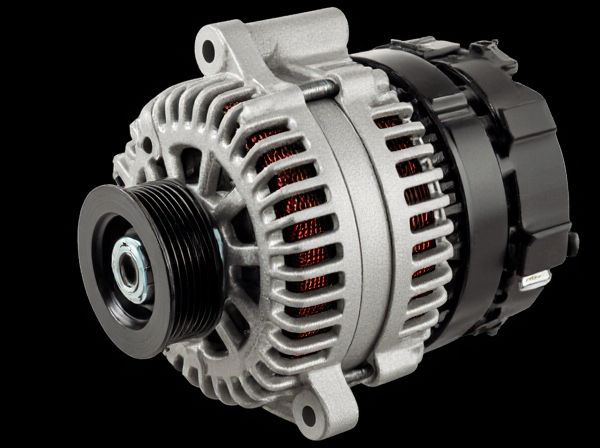
Photo illustration: Electro-Magnetic vs Permanent Magnet Alternator
Electro-magnetic alternators generate electricity by inducing current through a rotating coil within an electromagnet, offering adjustable magnetic field strength for variable output control. Permanent magnet alternators rely on fixed magnets to produce a constant magnetic field, enhancing efficiency and reducing maintenance due to the absence of field excitation components. Your choice depends on factors such as application requirements, efficiency, and system complexity.
Table of Comparison
| Feature | Electro-Magnetic Alternator | Permanent Magnet Alternator |
|---|---|---|
| Magnet Type | Electromagnets (field coils) | Permanent magnets (rare earth magnets) |
| Power Efficiency | Moderate efficiency due to energy loss in coils | Higher efficiency with minimal energy loss |
| Output Consistency | Voltage varies with field current control | Stable voltage output without field current |
| Maintenance | Requires regular brush and slip ring inspection | Low maintenance; no brushes or slip rings |
| Weight | Heavier due to coils and additional components | Lighter compact design with permanent magnets |
| Cost | Lower initial cost, higher maintenance expenses | Higher initial cost, lower lifetime maintenance |
| Applications | Common in traditional vehicles and heavy-duty engines | Preferred in modern vehicles and hybrid systems |
Introduction to Alternators
Alternators convert mechanical energy into electrical energy using electromagnetic induction. Electro-magnetic alternators rely on an external field coil to generate the magnetic field, allowing adjustable output voltage and current. Permanent magnet alternators use fixed magnets, offering higher efficiency and simpler construction but limited control over output voltage.
Understanding Electro-Magnetic Alternators
Electro-magnetic alternators generate electricity through a rotating magnetic field created by electromagnetic coils energized by an external power source, allowing precise control of voltage output. These alternators are commonly used in applications requiring adjustable and stable voltage supply, such as power plants and heavy machinery. Their reliance on electromagnetic excitation enables flexibility in design and operation, contrasting with permanent magnet alternators that use fixed magnets and lack voltage regulation capabilities.
Overview of Permanent Magnet Alternators
Permanent Magnet Alternators utilize high-strength rare earth magnets, such as neodymium, to generate consistent magnetic fields without the need for external excitation, resulting in higher efficiency and reduced maintenance compared to electro-magnetic alternators. Their compact design and improved power density make them ideal for applications in renewable energy systems, electric vehicles, and aerospace industries. The absence of brushes and slip rings in these alternators minimizes mechanical wear, enhancing reliability and operational lifespan.
Key Components Comparison
Electro-magnetic alternators utilize rotor windings energized by an external DC source to produce a magnetic field, while permanent magnet alternators rely on embedded rare-earth magnets for consistent magnetic flux without external excitation. Key components of electro-magnetic alternators include slip rings, brushes, and rotor windings, which require maintenance and can suffer wear over time. In contrast, permanent magnet alternators feature a simpler construction with rotor magnets, eliminating brushes and slip rings, resulting in higher efficiency and reduced maintenance needs.
Efficiency and Performance Differences
Electro-magnetic alternators typically have lower efficiency due to energy losses in field excitation, while permanent magnet alternators achieve higher efficiency by eliminating the need for external excitation power. Performance-wise, permanent magnet alternators provide consistent voltage output and better responsiveness at low speeds, whereas electro-magnetic alternators offer adjustable field control, allowing for variable voltage regulation under different loads. The permanent magnet design reduces maintenance requirements and improves overall energy conversion efficiency, making it preferable for applications demanding high reliability and performance.
Cost and Maintenance Considerations
Electro-magnetic alternators generally have lower upfront costs due to simpler construction and standardized components, while permanent magnet alternators require higher initial investment because of the costly rare-earth magnets. Maintenance for electro-magnetic alternators is more frequent since brushes and slip rings experience wear and need regular replacement, in contrast to permanent magnet alternators that offer reduced maintenance with no brush or slip ring wear. Long-term operational costs tend to be lower for permanent magnet alternators due to their increased efficiency and durability despite the higher initial expense.
Applications and Suitability
Electro-Magnetic alternators, known for their controllable field excitation, are ideal for applications requiring variable output and precise voltage regulation, such as industrial generators and large power plants. Permanent magnet alternators offer higher efficiency and reduced maintenance, making them suitable for renewable energy systems like wind turbines and small-scale hydroelectric generators. The choice depends on factors like load variability, maintenance capacity, and energy source characteristics.
Advantages of Electro-Magnetic Alternators
Electro-magnetic alternators offer superior control over voltage output by adjusting the field current, enabling more precise regulation in varying load conditions. They provide greater durability and reliability in high-power applications due to their robust construction and ability to handle thermal stress. Maintenance is often simpler and less costly since the electromagnetic field can be adjusted or repaired without replacing permanent magnets.
Benefits of Permanent Magnet Alternators
Permanent magnet alternators (PMAs) offer higher efficiency by eliminating the need for external excitation current, resulting in reduced energy losses and lower heat generation. PMAs provide enhanced reliability and lower maintenance since they lack brushes and slip rings, minimizing wear and mechanical failures. Their compact size and lighter weight make them ideal for applications requiring space-saving designs and improved power density.
Choosing the Right Alternator for Your Needs
Electro-Magnetic alternators offer adjustable field excitation, making them ideal for applications requiring variable power output and voltage regulation, such as industrial machinery and heavy-duty generators. Permanent Magnet alternators provide higher efficiency and lower maintenance due to their fixed magnetic field, making them suitable for renewable energy systems and portable power solutions. When choosing the right alternator, prioritize factors like load stability, durability, maintenance frequency, and overall energy efficiency to match your specific application requirements.
 caratoz.com
caratoz.com